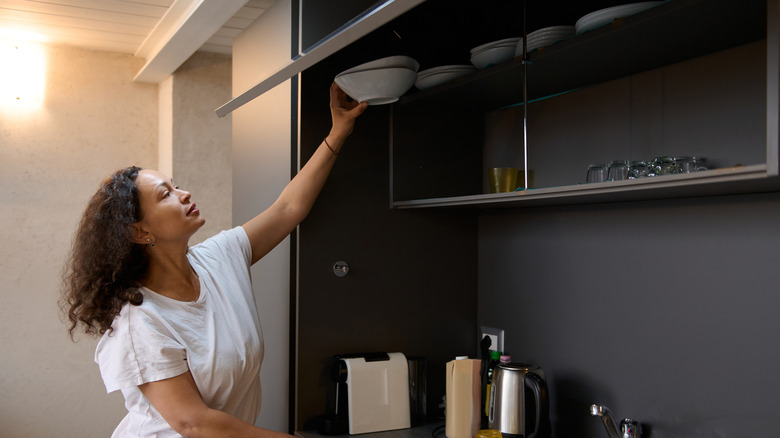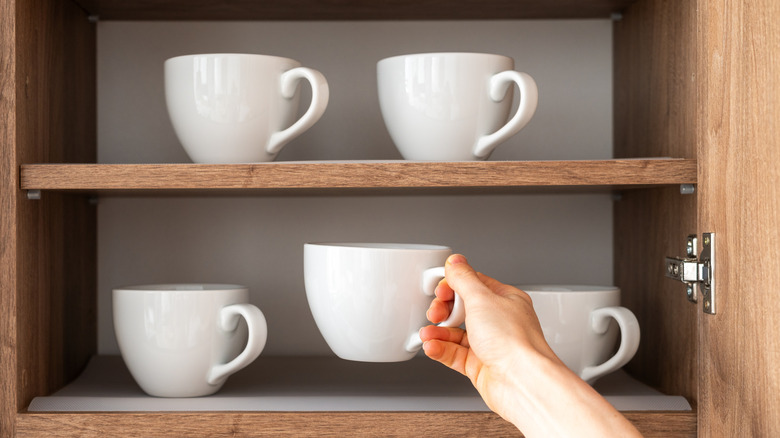Why The KonMari Method Works Well For Decluttering A Kitchen
There are a lot of notable interior design and home organization personalities that have graced the television screen — one of the most notable being Marie Kondo. This Japanese organizing expert has taken the minimalism and home management world by storm, with many individuals swearing by her "KonMari" method for tidying up and getting their homes under control. While there's no magic solution to a streamlined and clutter-free kitchen (you'll just have to roll up your sleeves and get started), various approaches posited by Kondo work exceptionally well when it comes to decluttering your kitchen.
If you're wondering why the KonMari method works so well for decluttering a kitchen, it's because it embraces practicality around your items without dismissing the emotions tied up in physical goods — providing a well-rounded approach. Practically speaking, here's what to know before starting the KonMari method in your messy kitchen. Chief among Kondo's principles is the idea of joy, and only keeping items in your space that help to elicit that emotion — or, as Kondo puts it "does this spark joy?" Another one of Kondo's hallmark organization moves is to dump everything from one category in a big pile — this approach should make you feel both overwhelmed by your possessions, as well as give you clarity about what to keep. While these approaches may seem extreme or unconventional, they may just be the key to finally getting your kitchen inventory under control.
Pull everything out of your cupboards to see how much you have
If you want to declutter and organize your kitchen like Marie Kondo, you'll need to get a feel for how much you have. This means dumping everything out of one space into a big pile. Why, you may ask? It's easy to find a corner of your kitchen cabinet or drawer in which to cram one more cookie sheet or spatula, but with all of the inventory stashed into a drawer, you run the risk of accumulating more and more, never finding time to curate your collection or to properly organize it. Placing all of your kitchen utensils, for example, in one big pile, can help you see that you have one too many whisks, making it easy to part with the extra.
Once an area of your kitchen is empty, you'll want to be intentional about what you put back. Sort through your pile of kitchen clutter, holding each item, and ask yourself the question, "does it spark joy?" Since the kitchen is such a vital station in the home, it might be tempting to overemphasize the functionality of certain items, rather than the feelings you have about them; just remember that you're more likely to use something if it's an item you actually adore. Perhaps you love the way that your ground beef chopper performs on taco Tuesday, or the aesthetic of that little teapot that you acquired on vacation. This gives you absolute freedom to get rid of whatever doesn't bring you happiness.
Dealing with your curated inventory
Kondo is big on optimizing your organization, which is why she recommends measuring a space before returning your pared-down collection of items back to their home. This can serve as a final decluttering filter for your kitchen belongings. If you find any items that don't fit in a space well, that may signal that said items need a new home. It's normal to feel sentimental about items that you are decluttering, so if you're holding a joy-sparking item in your hands that just doesn't fit in your cabinets, you'll likely figure out another place to store it. On the other hand, an oversized juicer that you feel blasé about, may be an easy item to say goodbye to.
While you may initially be despondent by the amount of items you're getting rid of — be prepared for complex emotions and questions like, "Why did I waste my money on this?" These feelings can be a good sign that your kitchen will be highly efficient in terms of inventory, and expertly curated for smoother operations moving forward.
Once you have a pile of decluttered items to part with, Kondo recommends finding a good home for said items. This might be a donation facility or a recycling location for a certain material, although you can feel free to share your decluttered pieces with friends and family — as long as they are in good condition. That extra whisk you discovered might just be a welcome addition to your friend's whisk-less kitchen.


